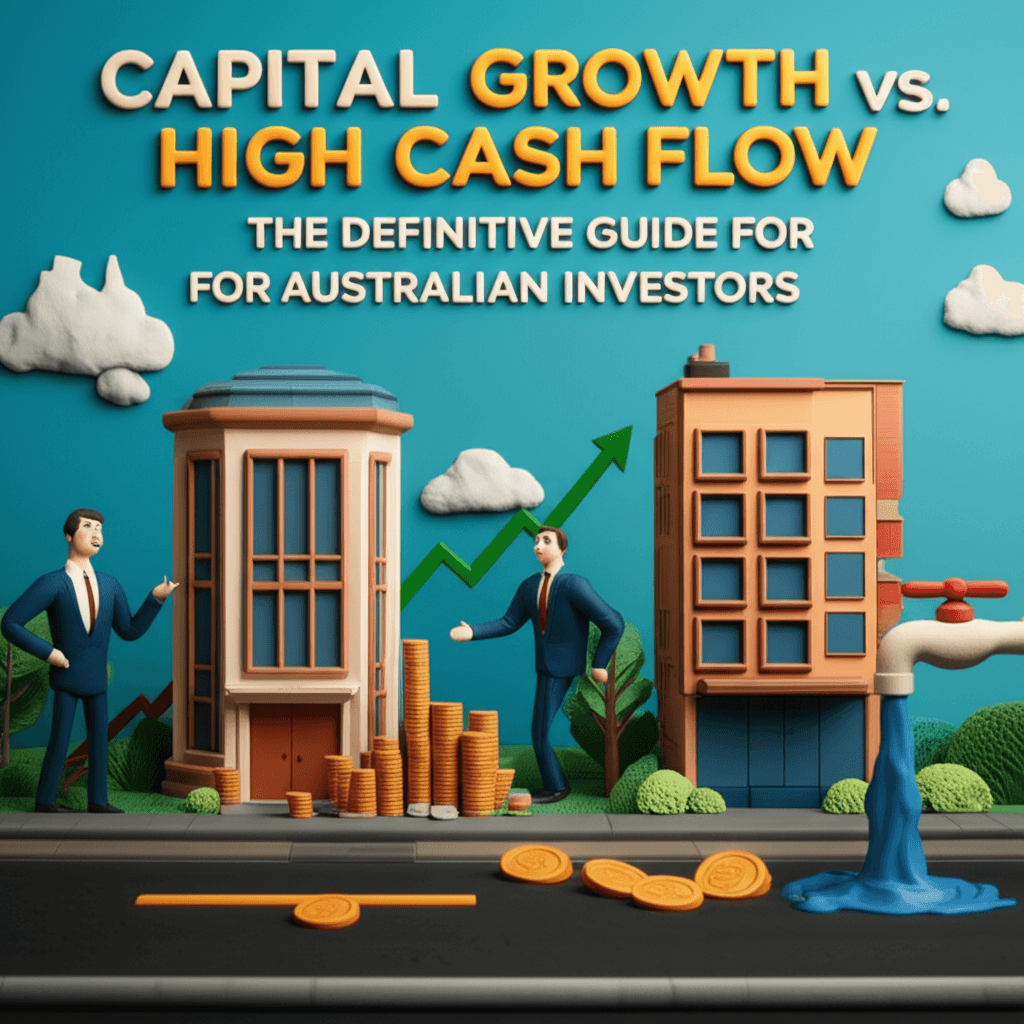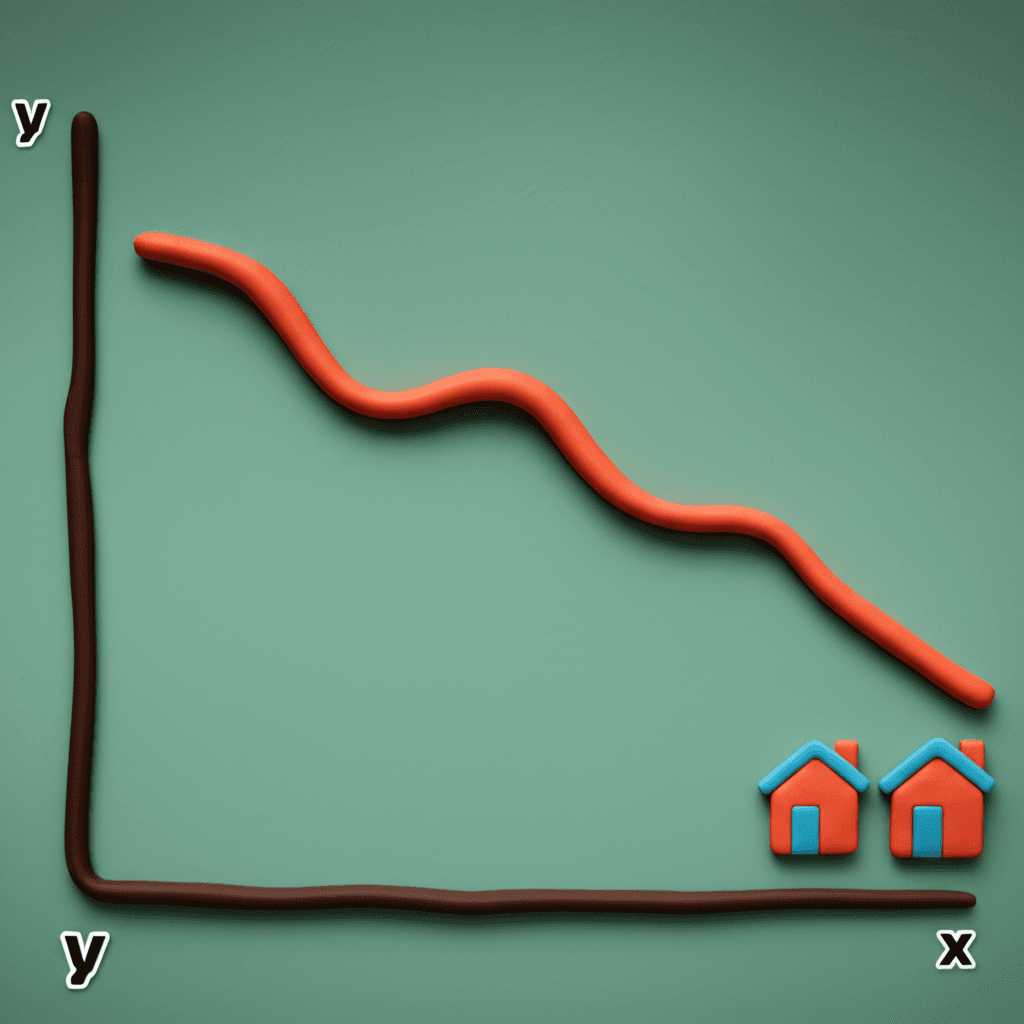Capital Growth vs. High Cash Flow: The Definitive Guide for Australian Investors
Uncover the serviceability limits of a high-yield strategy and learn why data-driven capital growth is crucial for building a powerful portfolio.

The Great Investor Debate: Cash Flow vs. Capital Growth
Navigating the Australian property market in mid-2025 presents a fundamental choice for every investor: do you chase the immediate gratification of high rental yields or play the long game with capital growth? The allure of a 'cash flow positive' property that pays for itself from day one is powerful. However, many investors discover too late that this single-minded pursuit can lead to a portfolio that stagnates, hitting a borrowing ceiling far sooner than anticipated.
This guide cuts through the noise, debunking the myth of accumulating unlimited properties through cash flow alone. We'll explore the real-world limitations imposed by lender serviceability requirements and demonstrate why a strategic focus on capital growth, underpinned by powerful real estate analytics, is the true engine of long-term wealth creation.
The Serviceability Ceiling: Why You Can't Buy Unlimited Properties
A common misconception, often fueled by social media gurus, is that you can endlessly acquire cash flow positive properties because they 'pay for themselves'. In reality, banks and lenders have the final say, and their decision hinges on one critical factor: serviceability.
How Lenders View Your Portfolio
Even if a property generates a surplus, lenders don't see it as a simple plus-minus equation. They apply strict assessment criteria:
Shaded Rental Income: Lenders typically only consider 70-80% of your gross rental income when calculating your borrowing capacity. This buffer accounts for potential vacancies, management fees, and other expenses.
Assessed Interest Rates: They assess your ability to repay the loan at a much higher 'stress test' interest rate, often 2.5-3% above the actual rate. This is a regulatory requirement designed to ensure you can handle future rate hikes, as outlined by authorities like the Reserve Bank of Australia (RBA).
Reliance on Personal Income: Your PAYG salary or business income remains the primary driver of your borrowing power. Rental income is treated as a secondary, less reliable source.
This means that even with a portfolio of high-yield properties, you will inevitably hit a 'serviceability ceiling'. For an average investor earning $85,000 per year, this ceiling is often reached after acquiring five or six lower-value properties. At that point, your ability to borrow from mainstream lenders evaporates, halting your portfolio's growth in its tracks.

The Hidden Risks of High-Yield Investment Hotspots
To achieve the 7-8% yields needed for a property to be cash flow positive, investors are often pushed towards specific regional or outer-suburban markets. While the numbers look appealing on paper, these areas can carry significant, often overlooked, risks.
Sacrificing Quality for Yield
High-yield markets can present several challenges that impact your long-term returns:
Lower Tenant Quality & Higher Vacancy: Cheaper properties can attract a more transient tenant base, leading to higher turnover, increased vacancy periods, and greater management headaches.
Increased Maintenance Costs: Properties in lower price brackets are often older and require more significant and frequent maintenance, eating into your cash flow surplus.
Lender Restrictions: Many lenders maintain 'blacklists' or impose stricter lending conditions on certain postcodes they deem high-risk. This can mean a lower Loan-to-Value Ratio (LVR), forcing you to contribute a larger deposit and limiting your leverage.
Stagnant Capital Growth: The most significant risk is minimal capital growth. Without growth, you cannot extract equity to fund future purchases. Your portfolio relies solely on your ability to save new deposits, a painfully slow path to wealth.
Focusing exclusively on yield limits the number of markets you can invest in, forcing you to overlook prime opportunities for capital appreciation in more stable, high-demand locations.
Creative Cash Flow Strategies: Weighing the Pros and Cons
Beyond chasing high-yield suburbs, some investors turn to creative strategies to boost a property's income. While viable, each comes with its own set of complexities.
Granny Flats
Adding a secondary dwelling can significantly increase rental income. However, with construction costs now pushing $180,000+, you must weigh the return on investment. If you have the borrowing capacity, that same $180,000 could serve as a deposit for an entirely new property worth over $700,000, offering far greater potential for capital growth. Finding properties with this potential is easier with an advanced AI property search that can identify larger blocks or dual-living opportunities.
Renting by the Room & Short-Term Stays (Airbnb)
These strategies can generate higher gross income but come with significant trade-offs:
Intensive Management: Both require constant administration, from managing multiple tenants to coordinating cleaning and changeovers for short-term stays.
Higher Vacancy Risk: Income can be inconsistent and seasonal. Lenders are often wary of this income stream unless you have a multi-year track record.
Increased Expenses: Higher wear and tear, utility costs, and cleaning fees can erode the higher rental income.
These are more akin to running a small business than a passive investment and can complicate your journey towards building a scalable portfolio.
[INSERT_IMAGE: "A modern graphic representing an AI-powered property search on a laptop screen, showing filters for 'granny flat potential' and 'high capital growth forecast'"]
The Engine of Wealth: Why Capital Growth is King
The ultimate goal of property investing is to build a substantial asset base that provides for your future. While cash flow manages the holding costs, capital growth is what builds your wealth.
Consider this data-driven comparison:
High-Yield Property: A $500k property with a 7.9% yield might be cash flow neutral. After five years of modest 3% growth, it's worth approximately $579,000. Your equity gain is $79,000.
Growth-Oriented Property: A $750k property in a high-demand area might have a lower 3.7% yield, costing you $200/week to hold. However, with a stronger 7% annual growth rate, its value could reach over $1,050,000 in five years. Your equity gain is over $300,000.
This substantial increase in equity is what allows you to refinance and pull out a deposit for your next purchase, creating a powerful compounding effect. A sophisticated AI Buyer's Agent can help you identify these high-growth potential markets by analysing hundreds of data points, moving beyond simple yield calculations.
Conclusion: Build a Balanced, Growth-Focused Portfolio
The path to a successful, retirement-ready property portfolio is not paved with a single-minded pursuit of cash flow. It's built on a balanced and strategic approach that prioritizes long-term capital growth.
Key Takeaways:
Serviceability is Your Limit: Your income, not a property's cash flow, dictates your borrowing power. Relying on high yields will lead to a growth ceiling.
Capital Growth is Your Fuel: Equity growth is the fastest and most effective way to expand your portfolio and build life-changing wealth.
Data Beats Dogma: Don't follow simplistic advice. Use comprehensive data to analyse markets, understand the trade-offs between yield and growth, and make informed decisions tailored to your financial phase.
Instead of asking, "Does this property pay for itself?", start asking, "Where will this property be in 10 years?" The answer to the second question is what truly matters.
Ready to build a smarter, growth-focused property portfolio? Explore HouseSeeker's powerful [real estate analytics](https://houseseeker.com.au/features/real-estate-analytics) to uncover markets with the highest potential for long-term capital growth and secure your financial future.
Frequently Asked Questions
How many investment properties can I realistically buy?
For most PAYG earners, the serviceability ceiling with mainstream lenders is typically hit between 4 to 6 properties, especially if the portfolio consists of lower-value, high-yield assets. Your personal income and existing financial commitments are the primary determinants of your borrowing capacity, not the rental income alone.
Are granny flats a good investment for cash flow?
Granny flats can provide a strong boost to cash flow, but you must conduct a thorough cost-benefit analysis. With construction costs exceeding $180,000, you need to determine if that capital could be better deployed as a deposit on a separate, high-growth asset. It depends on whether your immediate priority is cash flow supplementation or portfolio expansion.
Should I use a trust to buy investment properties?
Buying properties in a trust structure can be a strategy for experienced investors looking to manage land tax or potentially overcome serviceability hurdles with specific niche lenders. However, it comes with significant complexity and costs, including set-up fees, annual accounting, and legal advice. In some states, trusts also have a lower land tax threshold. This is an advanced strategy that requires specialist advice from your accountant and lawyer.
